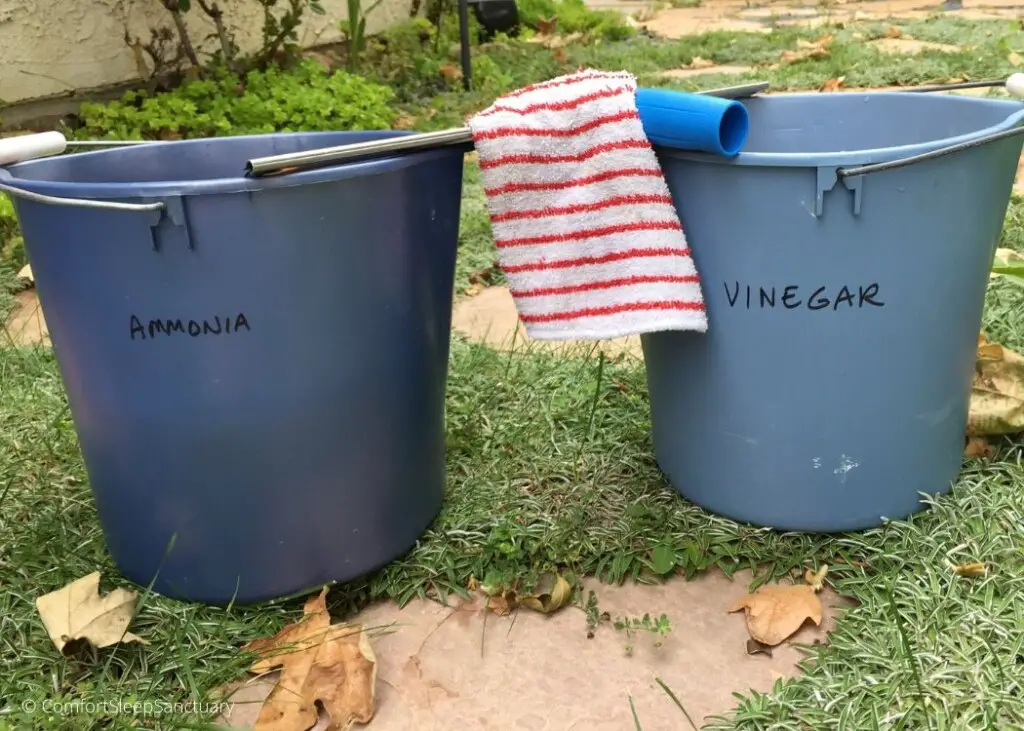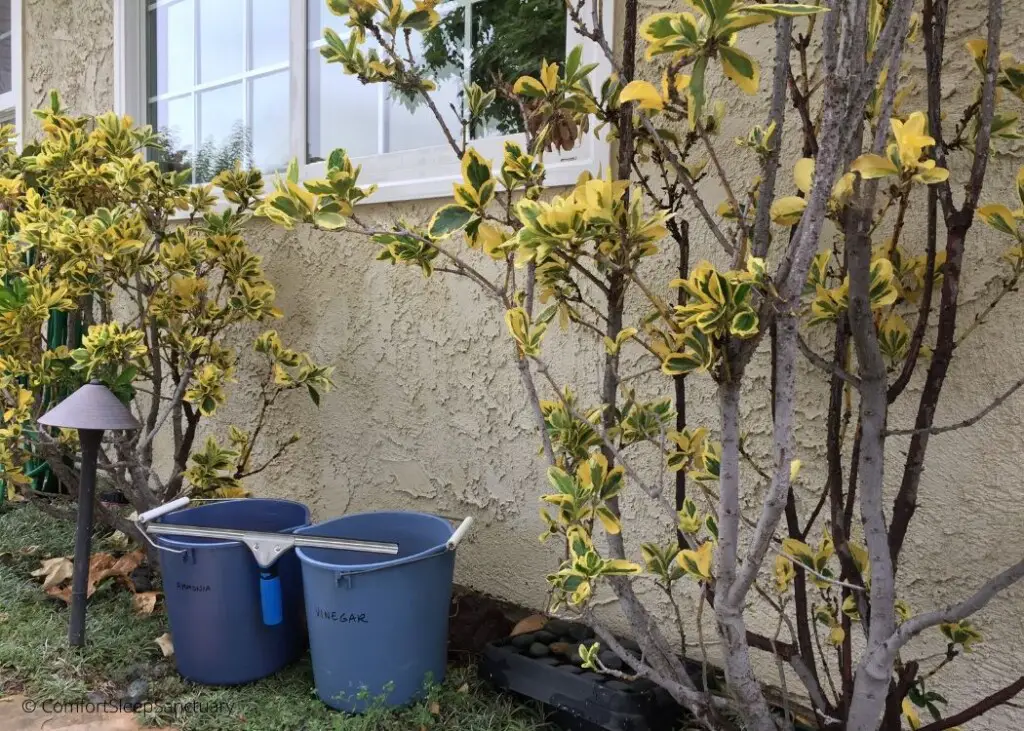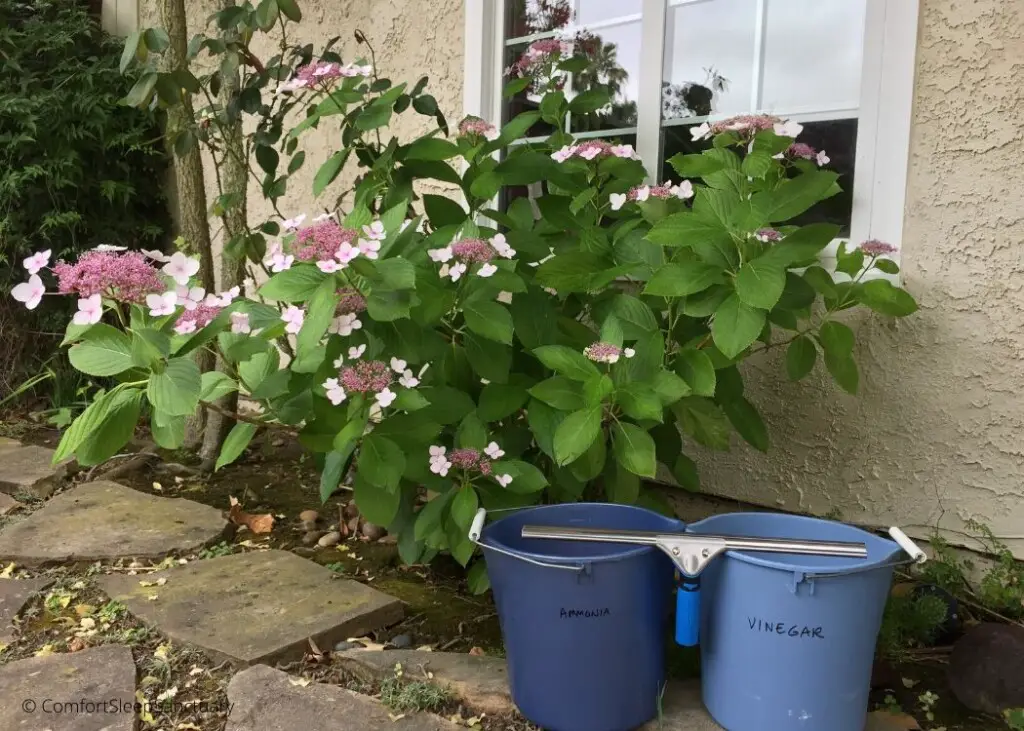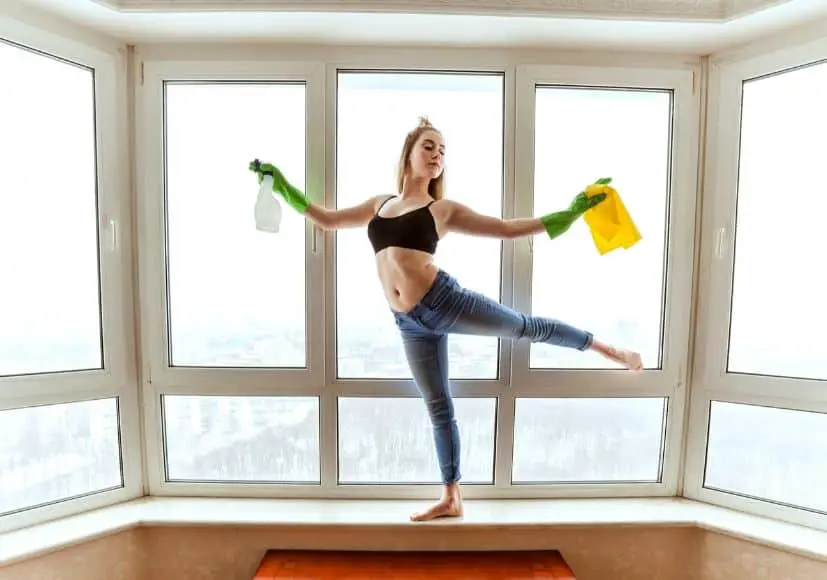Table of Contents
**This page contains affiliate links and I will be compensated if you make a purchase after clicking on my links**
It’s that time of year (again). The rainy season has officially ended and it’s time to wash all my windows. My go-to method is to use diluted ammonia in water, but the internet seems to prefer diluted vinegar instead.
This is understandable. Regular vinegar that you purchase from your grocery store is safe to eat and makes a nice vinaigrette for your salad.
Ammonia, even diluted, not so much…
Despite its safety for use around the home, does vinegar work as well at cleaning? Especially, for windows.
- Either ammonia OR vinegar will produce clean, streak-free windows. The choice is yours. However, if you have plants or flagstone under your windows, ammonia is probably the safer choice for them. Vinegar is a safer choice for you.
What is ammonia and why is it a good cleaner?
Ammonia is a gas with the formula NH3. This gas has a familiar pungent smell that most of us try and avoid.
Ammonia has many uses, but the most common is for cleaning or in fertilizer (plants love nitrogen).
Concentrated household ammonia is ammonia dissolved in water at a concentration of 5-10%. Dissolved, ammonia becomes a weak base (alkaline), called ammonium hydroxide, with the formula NH4OH.
Bases are caustic, which means they are good at dissolving stuck-on gunk on your windows or your oven, but also can irritate, and even burn your skin at high concentrations. (The label on the ammonia bottle warns against “prolonged” skin contact.)
When you open a bottle of ammonia the gas immediately starts to escape. This property is also helpful for cleaning. As the ammonia prefers to be in a gaseous NH3 form, it evaporates quickly, helping to prevent streaks and spots. Therefore, ammonia is popular for cleaning glass.
Indeed, the glass cleaner Windex® is made mostly of dilute ammonia (in water) and isopropyl alcohol, which both evaporate quickly.
Gaseous ammonia is also useful for cleaning ovens. For a particularly crusty job, you can leave a saucer of ammonia in the oven for several hours before cleaning.
Ammonia gas in small doses is fine, however be careful not to spill the bottle.
- In a 2005 study by Fedoruk, et. al, exposure of ammonia in the air was assessed using different types of ammonia-based cleaners.
- Using—or even spilling—a diluted ammonia cleaning solution (0.1-0.2%) was okay.
- However, the use of concentrated household ammonia (e.g. 3%) generated airborne ammonia levels that “exceeded occupational short-term exposure limits”.
High levels of ammonia gas can irritate and burn the skin, mouth, throat, lungs, and eyes.
Ammonia safety tips
Most of these are from the back label on the ammonia bottle, mixed with a little common sense.
- For routine cleaning, don’t use ammonia straight. Dilute it in water per the instructions.
- For particularly challenging cleaning chores, straight ammonia can be used, but only in a VERY WELL-VENTILATED area. For example, cleaning your outdoor grill.
- When creating a diluted cleaning solution, open the bottle of ammonia only in a location with good ventilation, e.g., your open garage or outside.
- If you get it on your skin or eyes, flush with water. For your eyes, flush with water for at least 15 minutes, then seek medical attention.
- If someone swallows it, give water or milk, but do not induce vomiting. Immediately seek out medical attention.
- And NEVER EVER EVER mix ammonia with bleach. Bleach plus ammonia creates toxic chloramine gas, which in large doses can be fatal…
(Side note: never mix bleach with acids either; toxic chlorine gas will result.)

What is vinegar and why is it a good cleaner?
Vinegar is acetic acid with the formula CH3COOH. The white vinegar on your grocery store shelf is around 5% acetic acid.
Obviously, vinegar at this dilution is a weak acid, or we would not be able to enjoy it in our food. But its acidic properties help dissolve mineral deposits and stuck-on resin, including the resin from annoying price tags.
How to descale your coffeemaker or espresso-maker
- If your coffee- or espresso-maker is working poorly, dilute white vinegar in water and run it through to dissolve mineral deposits.
Vinegar will also disinfect your coffeemaker to some extent. If like me, you have “green stuff” growing in your water reservoir, soak it in vinegar.
How much vinegar? You can use undiluted white vinegar (5%), but that will require sending water through your machine for many rounds before you can use it again.
You may need to run an entire water reservoir through. Twice. And even then, the next several cups of coffee may have a slightly acidic “bight” to the flavor.
I prefer to use diluted vinegar and descale more often.
How to descale your shower head and bathroom fixtures
Scale also collects in and around your showerhead. Place undiluted white vinegar in a Ziploc bag and place the whole thing around your shower head. Secure it with a rubber band.
(Tip: put the rubber band around the showerhead, first, before trying to place the bag. Tip 2: there may be a button to remove the showerhead, especially if it’s attached to a hose.)
Depending on the amount of scale, leave it for a few hours to overnight.
Put white vinegar in a spray bottle and spray your scaly fixtures. Let sit before wiping. For stubborn scale, repeat as needed.
Note, some metal finishes might not hold up to the application of an acid, albeit a weak acid.
Likewise, do not spray vinegar (or any other acid-based cleaner) on your stone, granite, or marble bathroom countertop.
How to use vinegar in your laundry
Use vinegar during the rinse cycle. Add up to one-half cup of white vinegar in the fabric softener dispenser to help rinse away detergent and other additives.
Do not use vinegar in the wash cycle with detergent. As a mild acid, vinegar neutralizes mildly alkaline things such as laundry detergent, canceling the benefit of both. This is one reason it works great during the rinse cycle.
- Likewise, never mix acids, such as vinegar, with bleach. Toxic chlorine gas results.
Vinegar works far better than fabric softener. The latter leaves a coating on your laundry that attracts grime faster and interferes with the fabric’s ability to breathe and wick away moisture.
You can also use vinegar in your dryer. Make your own DIY dryer sheets by soaking cotton cloths in a jar of white vinegar. Pull one out, wring out the extra liquid over the jar, and add the cloth to your dryer.
How to use vinegar to clean hard surfaces around the house
Spray white vinegar on solid surfaces to clean them. For especially challenging gunk, leave on for 15 minutes before wiping clean.
Vinegar works especially well for polishing metals, such as chrome, copper, and pewter.
- However, if you have natural stone, such as marble, granite, or soapstone, NEVER use acids on them. No lemon juice, no “natural citrus” cleaners, and certainly NO VINEGAR.
That also includes manufactured surfaces made from natural stone, such as quartz.
Vinegar dissolves stone… which is why it is so good at cleaning scale…
(While we’re on the topic, many “natural citrus” ingredients from lemons or oranges are toxic to cats and other pets. Yes, they smell nice, but STOP using these cleaners.)
And obviously, no vinegar on wood, either.

How to use vinegar to kills weeds
Vinegar can also work as an herbicide to kill weeds. Place vinegar in a spray bottle and spray the invaders directly. Vinegar is not selective: if you get it on the good plants they may die.
Note that your 5% acid, white vinegar solution may not be fully effective for this purpose.
Vinegar is also available in industrial-strength solutions of either 20% or 30% acetic acid. If you use a lot of vinegar for cleaning it can be useful to have larger quantities to dilute down.
- BEWARE. Vinegar solutions of 11% or greater can burn the skin. If it gets in your eyes, you could suffer severe injury, including blindness
For killing weeds, my bottle of 30% concentrated vinegar recommends using it at FULL STRENGTH.
I was planning to test this out in my own yard, but then I realized something:
- Do not use concentrated vinegar around natural stone in the yard, such as flagstone
Concentrated vinegar safety tips
This is from the back of my bottle of concentrated vinegar, plus the link below.
- Wear rubber gloves.
- As with ammonia above, if you get it on your skin or eyes, flush with water. For your eyes, flush with water for at least 20-30 minutes, then seek immediate medical attention.
- If ingested, do not induce vomiting, but rinse your mouth with water. Immediately call poison control or a doctor.
- When diluting, do so in a well-ventilated area. If you inhale the vapors, seek out fresh air. Seek medical attention if irritation persists.
It’s important to remember that anything at a high enough concentration can be dangerous. The goal is to find the ideal concentration of either ammonia or vinegar that works for cleaning but has minimal risk.
Of the two, vinegar has the edge, as simple edible 5% acid, white vinegar can accomplish most cleaning tasks.
How is vinegar made?
Typically, vinegar is made through distillation using corn (white vinegar), apples (apple cider vinegar), or grapes (white or red wine vinegar).
During this process, oxygen is introduced to the distilled alcohol to make acetic acid.
(Often times this happens accidentally, for example, a fine wine with the bad cork will let in oxygen and turn to vinegar.)
Do not mix vinegar and ammonia
Although it’s certainly not dangerous—like ammonia and bleach—mixing vinegar and ammonia is not recommended.
One is an acid, the other a base. If you recall from your high-school chemistry, the two together make salt plus water. In other words, the cleaning efficacy of both has been negated.
The temporary reaction of the two together has been used to clean surfaces, but both ingredients need to be added together at the same time on the surface in question.
For most cleaning, choose one or the other, but not both.

How to wash grimy outdoor windows with either ammonia or vinegar
What you’ll need:
- Garden hose and a spray nozzle. Ideally, the garden hose (or hoses) should be long enough to reach all windows
- A big stack of old rags. If you have special microfiber glass cleaning rags, save those for inside.
- High-quality “professional” squeegee. Your success (or failure) is highly dependent on the quality of the rubber blade. The blade should be smooth with no noticeable wear.
- Bucket and sponge
- Your cleaner of choice, either ammonia or vinegar (but not both)
Wake up early
No sleeping in. It’s best to wash windows during the cool morning hours. Once it becomes sunny or hot, the windows dry too fast, resulting in water spots.
Remove and wash the screens
From the inside pop out your screens. DON’T FORGET TO CLOSE YOUR WINDOWS.
Place the screens on the lawn or prop them up on your outdoor furniture and hose them off.
The high pressure from your spray hose should be enough to thoroughly clean them. If some dirt is being resistant, let it sit wet for a moment while you move on to the other screens. Return to the stubborn spot after it has had an opportunity to soak.
If you need to, scrub with some of the diluted glass cleaning solution (see below). Or spray with an environmentally friendly cleaner (so you don’t harm your lawn).
Spray down your windows
Using your hose and spray nozzle, spray down all your windows with water to remove all loose dirt. Don’t forget the dirt sitting at the top and sides.
If your hose doesn’t reach, you’ll need to individually sponge down each window to remove all that grime. For this stage diluted dish soap would probably work better than diluted ammonia or vinegar.
Often, out of laziness, I’ll spray down my windows and stop there. But more often than not, the windows will look WORSE than before. The next steps are critical.
Squeegee your windows
In your bucket dilute either vinegar or ammonia per the manufacturer’s instructions.
Make around 1½ gallons. Depending on the number of windows to wash, you may need to make a new batch halfway through.
My bottle of ammonia recommends a half-cup ammonia per gallon of water. You don’t need to be exact and can always use less if you wish.
My bottle of concentrated vinegar recommends diluting 1:5 which would bring it down to 5%, the concentration of regular undiluted vinegar. For comparison, that would be roughly 3 cups added to a gallon of water.
(Vinegar doesn’t need to be that concentrated for windows. For my experiment below, I diluted to half-strength or 2.5% acetic acid.)
Sponge down the window with your glass cleaning solution. Because you pre-washed off most of the dirt with your spray-hose, there should only be a minimal amount left to scrub.
At this point, don’t move on to the next window; you’ll need to finish this window before it has a chance to dry.
Using a dry cloth, dry a narrow strip across the window at the very top.
Now squeegee your window. Start at the top and pull down in one fluid motion: no stopping along the way. Between swipes, use the rag to dry the squeegee blade. Move from left to right (or right to left), along your window, starting at the top, and overlapping a bit with each swipe.
If it doesn’t look perfect, you can redo it. Switch out the drying rag as it gets damp.
If you missed a spot, use a dry, lint-free rag on the area. Note that old rags or wash clothes that have been washed a gazillion times are effectively “lint-free”.
Repeat with the next window.
Once everything is dry, replace your screens.
- There’s no rule that you have to replace all your screens. If there are a few windows that you NEVER open, instead, store the screens out of the way. Like in your attic. You’ll improve your view and next time window washing will go faster.

Cleaning windows on the inside
In principle, you can do the same things indoors, just make sure you have plenty of towels in place to protect your furniture and floors.
Because the inside of the windows is significantly less grimy, instead I use Windex® and a lint-free microfiber cloth designed for windows.
You’ll recall Windex® is made of dilute ammonia plus isopropyl alcohol. Alternatively, you can use vinegar in a spray bottle. For windows, vinegar may either be diluted or used at full strength (5%).
When using a spray bottle of either formulation, less is more. Spray the cloth first and use the lightly damp cloth on your windows. Use a dry cloth to make sure the windows are completely dry and streak-free.
Without the squeegee there is more risk of streaks and spots. In the old days I tried to wash the outside by spraying on Windex®. It did not go well…
Odds are, as the day progresses and the light changes, you’ll notice more spots and streaks that you’ve missed both inside and out. Simply attack them with a dry cloth that has been lightly moistened with either Windex or vinegar.
What about the plants (or flagstone) under the windows?
I’m not worried about using ammonia-based cleaning solutions around plants. The ammonia is dilute and plants like ammonia-based fertilizer anyway. I’ve never noticed an issue.
I’m a little bit leerier of using vinegar, as high concentrations will kill plants. However, at the concentrations we’re using it should be okay…
Another concern is if you have decorative flagstone under your windows. If you use vinegar, use it at a dilute concentration only.
Disposing of ammonia or vinegar
When you’re done washing your windows, you’ll need to dump out your bucket of cleaning solution. I don’t dump it in the sink, but instead, pour it in a toilet. Toilet drains are designed to keep gases from coming back up, whereas drains in sinks, bathtubs, and showers, are not. Pouring it out in a drain outside is also acceptable.
However, only use your toilet if your sewage is connected to a central city system. If you have your own septic system, you won’t want to overwhelm it, and risk ammonia getting into the groundwater and possibly your well water. If this is the case, use your sink instead.
What about the undiluted vinegar or ammonia? As both are water-soluble you can dump both down the toilet along with a lot of water. Fill a bucket or two with water and carefully pour it into your toilet following the ammonia. Minimize splashing and avoid flushing, as this may cause some of the gaseous ammonia to disperse into the air.
Which is better for windows, ammonia or vinegar?
I put it off for a few more months… (This post was left in “draft” for quite some time…) But finally, I did a side-by-side comparison. The left panes of my windows were cleaned with a vinegar solution and the right panes with an ammonia solution.
As recommended, I used a half cup of ammonia per gallon of water. I diluted the vinegar to half strength or 2.5%.
And the results?
Honestly, I can’t tell the difference: both sides of my windows are streak-free and clean!
Which is right for you?
I’m concerned with the plants and flagstone under my window, so I probably will stick with ammonia. However, I now use either Windex® or vinegar for cleaning windows inside. Next time, I may test a vinegar solution that is more dilute.
If you are more concerned about your own safety, then vinegar is probably the better choice. However, both are very low risk when used as instructed.
Top image ©Kladyk via Canva.com
Want to learn more about the products mentioned?
[If you experience issues with menus or links not working, it is most likely due to your Ad blocker.]


